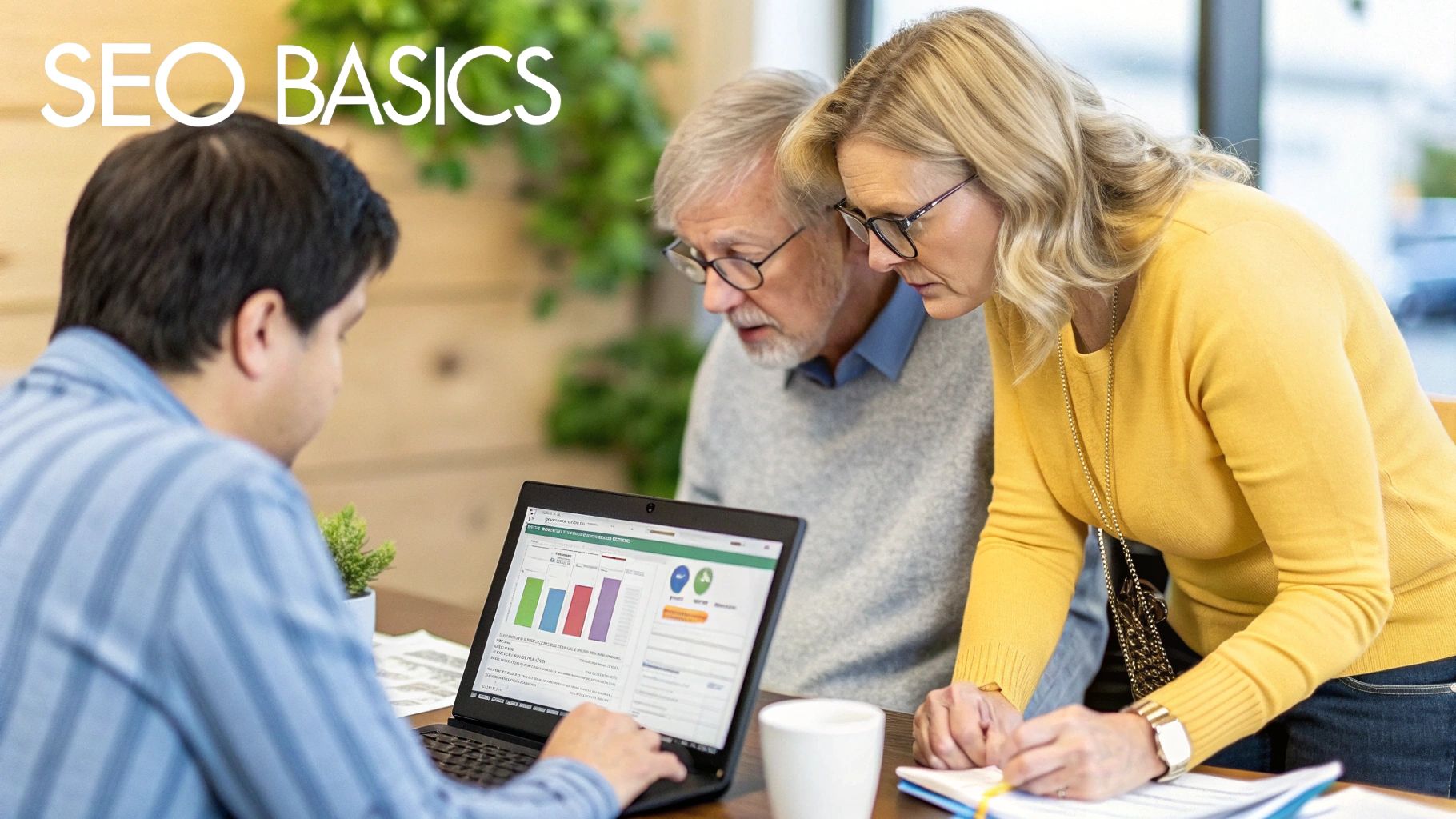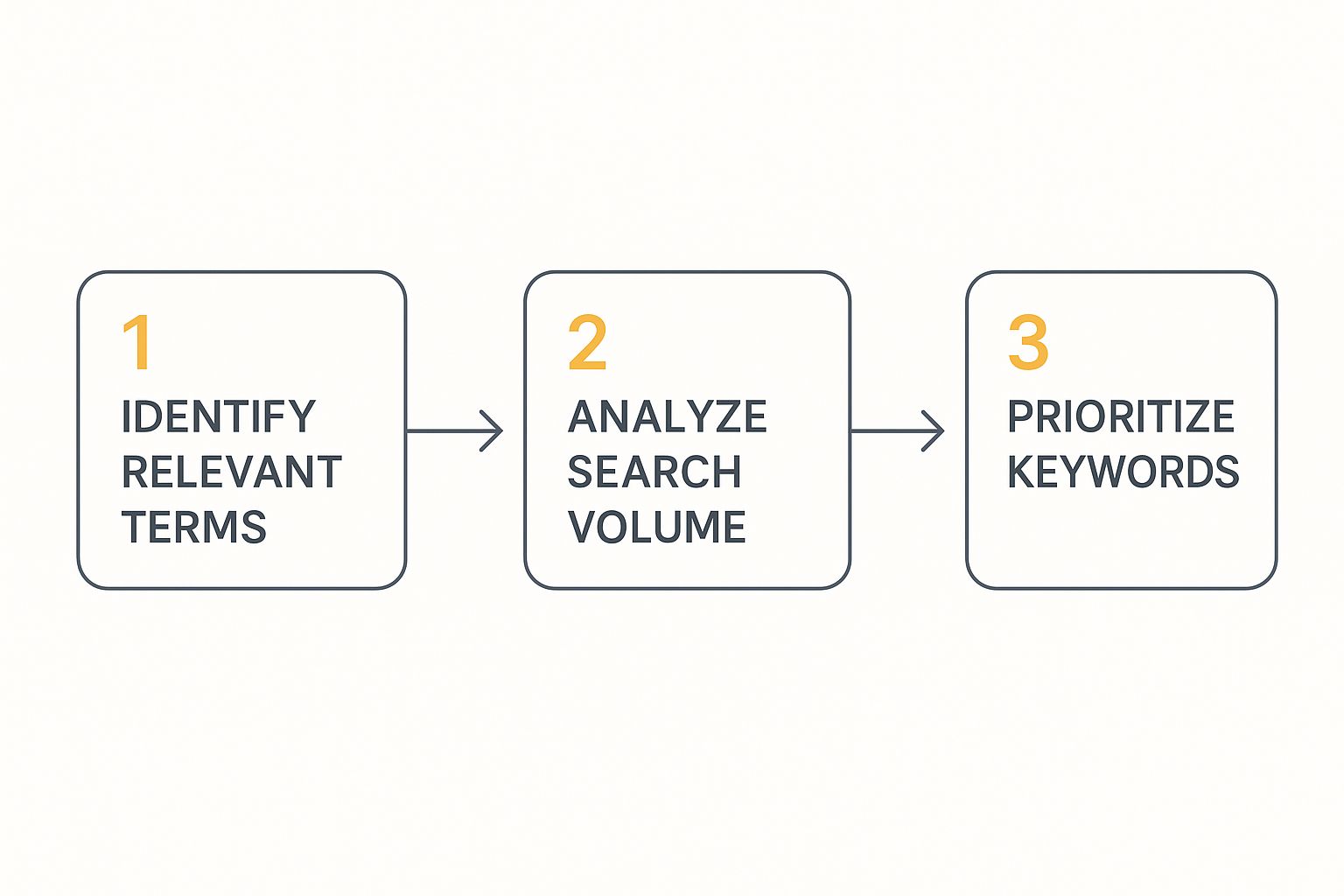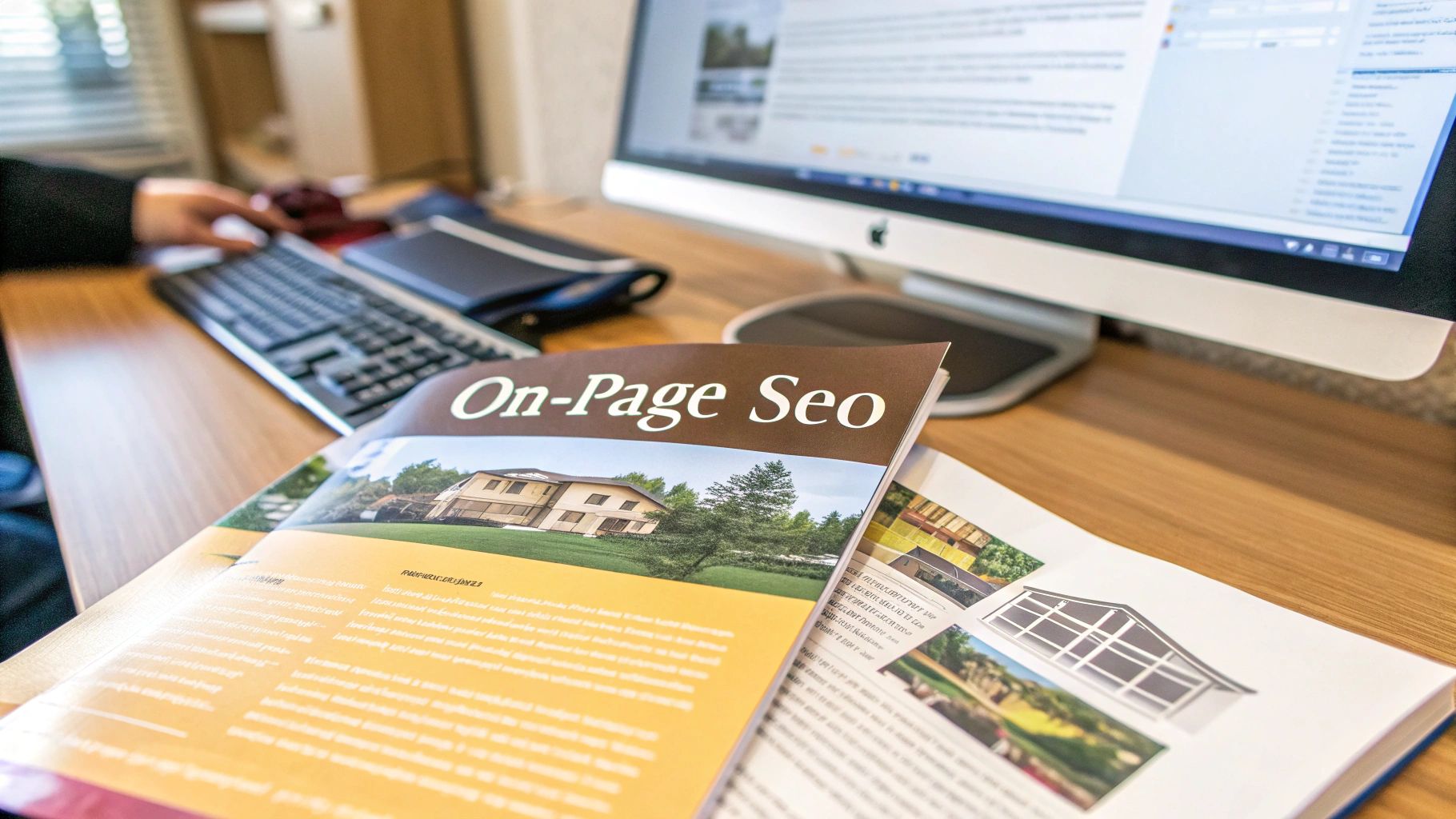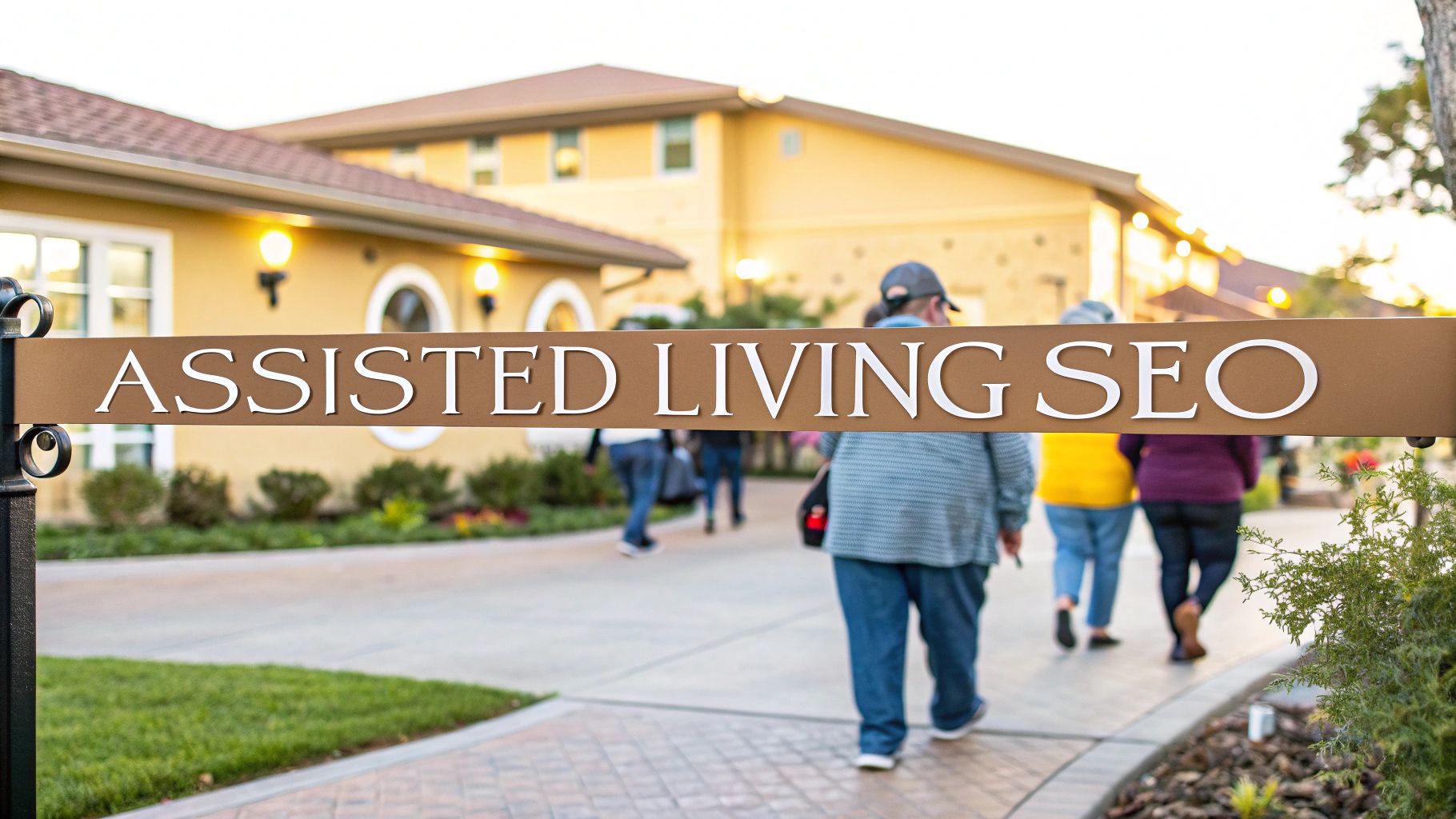Let's be real: the search for senior care is an emotional, often urgent, journey that almost always kicks off online. For assisted living communities, having strong SEO isn't just another marketing box to check—it's about being the first trusted resource a family finds on Google. It's the most fundamental way to build trust and bring in qualified inquiries.
Why SEO Is Your Most Critical Marketing Channel

Think about the typical scenario. An adult child notices their parent is struggling and opens their laptop. That first move is almost always a Google search. They type in questions filled with concern and uncertainty, looking for guidance, reassurance, and, ultimately, a solution.
This is the moment of truth where your community has to be visible.
The data backs this up. Research shows that over 90% of families start looking for senior living options online, making Google the front door to your community. If you aren't showing up on the first page, you’re basically invisible to the vast majority of potential residents.
To give you a clearer picture, let's break down the essential pillars of a solid SEO strategy. This table outlines what we’ll be covering, what each part accomplishes, and the main action you need to take.
Core Pillars of Assisted Living SEO
| Pillar | What It Achieves | Core Action Item |
|---|---|---|
| Keyword Research | Pinpoints the exact terms families use to find care. | Identify and target high-intent, location-based keywords. |
| On-Page SEO | Makes your website pages clear to both users and Google. | Optimize titles, content, and images for your target keywords. |
| Local SEO | Dominates searches like "assisted living near me." | Fully optimize your Google Business Profile and local citations. |
| Content Strategy | Builds trust by answering families' biggest questions. | Create helpful articles and resources about senior living topics. |
| Link Building | Signals to Google that your site is a trusted authority. | Earn links from reputable local and industry-specific websites. |
| Review Management | Uses social proof to build credibility and attract new families. | Actively encourage and respond to online reviews. |
| Performance Tracking | Shows you what's working and where to improve. | Monitor rankings, traffic, and leads to refine your strategy. |
Think of these as the building blocks. Get them right, and you'll have a powerful, lead-generating machine working for you around the clock.
Connecting with Families at Every Stage
The real magic of a good SEO strategy is its ability to meet families exactly where they are in their decision-making process. The journey is rarely a straight line; it's a winding path filled with different kinds of questions.
You'll see a mix of searches, like:
- Informational Searches: Early-stage questions like, "signs it's time for memory care" or "what is the cost of assisted living?"
- Comparison Searches: Mid-funnel queries like, "independent living vs assisted living" as families weigh their options.
- Navigational Searches: People looking for specific communities they've heard of, maybe searching "[Your Community Name] reviews."
- Transactional Searches: High-intent, local searches like, "assisted living near me" or "memory care in [Your City]."
When your community shows up for these different types of searches, you're not just seen as another option. You become an authoritative, helpful guide. That builds a foundation of trust long before a family ever picks up the phone or books a tour. For a solid primer on the basics, you might find resources on demystifying Search Engine Optimization (SEO) helpful.
SEO is more than just ranking for keywords; it’s about understanding the user's intent and providing the exact answer they need at a critical moment. For assisted living, this means offering empathy, clarity, and solutions directly in the search results.
Moving Beyond Traditional Marketing
Unlike a billboard or a radio ad that interrupts people, SEO connects with them at the precise moment they are actively looking for help. This makes the leads you get from search inherently more qualified and ready to listen.
When someone finds your community on their own terms, it feels like a discovery. That's a much more powerful introduction than a paid advertisement. Our own work in data-driven SEO marketing consistently shows that organic traffic converts at a higher rate. Why? Because it's built on a foundation of genuine user trust.
Dominate Local Search to Connect with Nearby Families
When a family starts looking for assisted living, their search is rarely national. It's hyperlocal. They aren't just browsing online; they're looking for care right around the corner for a parent or loved one.
This is why mastering local search isn't just a piece of a good SEO strategy for your community—it's the whole playbook. Every single lead you get will be a local one. This is about more than just "claiming" a profile; it's about turning your digital presence into a beacon for nearby families who need your help, right now.
The goal is simple: when someone in your area searches for care, your community needs to be the first and most trusted result they see.
Optimize Your Google Business Profile
For most families, your Google Business Profile (GBP) is the first impression they'll have of your community. It’s your digital front door. A neglected, half-finished profile sends a bad signal. But a vibrant, detailed one builds instant trust.
This is your chance to do more than just list your address and phone number.
- Write a Compelling Description: Don't just rattle off your services. Tell a story. What makes your community special? Weave in keywords naturally, like "compassionate memory care in [Your City]" or "vibrant independent living for active seniors."
- Choose Strategic Categories: Select a primary category and then add secondary ones that paint a full picture. Go beyond the basic "Assisted Living Facility" to include "Memory Care Center" or "Retirement Community" if they apply. This helps Google connect you with more specific, high-intent searches.
- Use the Q&A Feature: Get ahead of the questions you know families have. Proactively post and answer common queries like, "What are your visiting hours?" or "Do you offer specialized dementia care programs?" This shows you're transparent and thinking about their needs.
This is the main dashboard where you'll manage all these crucial parts of your profile. Getting familiar with it is a must.

Treat your GBP like a dynamic mini-website, not a static business card. That's how you start to pull ahead in local results.
Showcase Your Community With GBP Posts
Google Business Profile Posts are one of the most underused tools out there. They let you show, not just tell, what life is really like inside your community. These short updates pop up right on your profile and are perfect for highlighting the human side of your facility.
Use posts to announce an upcoming open house, share photos from a recent resident activity, or introduce a new member of your care team. Think about it: a post titled "Fun in the Sun at Our Annual Summer BBQ!" with a few photos of smiling residents is infinitely more powerful than a bulleted list of amenities.
This consistent activity also sends a strong signal to Google that your business is active, engaged, and relevant.
Build Authority With Local Citations and Backlinks
A huge part of local SEO for assisted living communities is building a strong web of trust signals. These signals tell Google that your community is a legitimate, well-respected authority in your specific geographic area.
Citations are simply mentions of your community's name, address, and phone number (NAP) on other websites. The key here is consistency. Your NAP information needs to be identical everywhere, from major industry directories like Caring.com to your local chamber of commerce website.
Building consistent citations across the web is a foundational part of local search rankings. It establishes your community's credibility. Inaccurate or conflicting information will only confuse search engines and hurt your visibility.
Just as important are local backlinks. These are links pointing to your website from other reputable local businesses and organizations. For example, if you sponsor a local charity 5K, ask them to link back to your site from their event page. Partner with nearby healthcare providers, senior centers, or community groups for cross-promotion.
These local partnerships do more than just provide valuable SEO juice. They reinforce your community's role as a trusted, integrated part of the local fabric. For a deeper look into this strategy, check out our guide on comprehensive local SEO services.
Create Content That Builds Unshakeable Trust

Content is where you stop being just another listing in search results and become a trusted advisor. For families going through the emotional process of choosing an assisted living community, trust is everything. This is your opportunity to answer their hardest questions with real empathy and authority, long before they ever think about picking up the phone.
Forget about generic blog posts like "five benefits of senior living." That's not what families are looking for. Your content needs to go much deeper. It has to embody what Google calls E-E-A-T (Experience, Expertise, Authoritativeness, and Trustworthiness). In simple terms, this means creating resources that show you genuinely understand the anxieties and details involved in this huge life decision.
Develop Cornerstone Content That Resonates
Cornerstone articles are the heavy lifters of your content strategy. These are comprehensive, in-depth guides that tackle the biggest concerns your audience has. They aren't quick reads; they're definitive resources that establish your community as a knowledgeable, caring leader. They also become magnets for backlinks, boost your seo for assisted living communities, and, most importantly, provide genuine help.
You'll want to focus your energy on creating pillar pages around these high-stakes topics:
- Navigating the Cost of Assisted Living: Break down the different payment options in plain English. Explain what Medicare and private insurance may or may not cover, and give a transparent overview of the value your community provides for the cost.
- How to Have the Conversation About Moving: Offer compassionate, practical advice for adult children on how to approach this incredibly sensitive subject with their parents. Provide scripts, tips, and reassurance.
- Understanding Different Levels of Care: Clearly map out the differences between independent living, assisted living, and memory care. Use real-world examples to help families figure out which solution is the right one for their loved one.
These topics directly match the questions families are typing into Google at the very beginning of their search. By giving them the best, most thorough answer, you build instant credibility. For more ideas, it's worth exploring proven content marketing strategies that work for small businesses.
To help you get started, here are some high-impact content ideas that we've seen work time and again for our clients. These topics are designed to answer critical questions and position you as an expert families can rely on.
High-Impact Content Ideas for Assisted Living
| Content Focus | Example Topic | Why It Works |
|---|---|---|
| Financial Guidance | A Complete Guide to Paying for Senior Care in [Your State] | Directly addresses the #1 concern for most families and provides locally relevant, actionable information. |
| Emotional Support | When Is It Time? 7 Signs Your Parent May Need Assisted Living | Helps adult children navigate a difficult, emotional decision-making process with clarity and confidence. |
| Community Life | A Day in the Life of an Assisted Living Resident at [Your Community] | Makes the experience tangible and less intimidating by showcasing daily activities, meals, and social interactions. |
| Caregiver Resources | A Checklist for Touring Assisted Living Communities | Provides a practical tool that empowers families during their search, building trust and demonstrating your expertise. |
| Health & Wellness | How We Support Residents with [Specific Condition, e.g., Dementia] | Shows deep expertise and compassion, reassuring families that their loved one's specific needs will be met. |
Creating just a few of these in-depth resources can dramatically shift how potential residents and their families perceive your community. You move from being a service provider to a true partner in their journey.
When a family is making a decision that impacts the health and happiness of a loved one, they are looking for more than a sales pitch. They are looking for expertise and compassion. Your content is the first and best place to deliver it.
Personalize With Location and Service Pages
While cornerstone articles build your overall authority, it's your location and service pages that turn that interest into actual inquiries. These pages can't just be a list of amenities. They need to feel personal, local, and highly relevant to what someone just searched for.
Location Pages: If you operate multiple communities, each one needs its own unique page. Don't just copy and paste the text and swap out the city name. Talk about the specific neighborhood, nearby parks or attractions, and what makes that particular location feel special. Weave in local keywords like "memory care in [Your City]" to catch those high-intent local searches.
Service Pages: Your individual pages for assisted living, memory care, or independent living should be crystal clear about what you offer. Use these pages to:
- Detail the Daily Experience: What does a typical day actually look like for a resident in this level of care? Walk them through it.
- Highlight Key Staff: Put a face to the names. Introduce the director of nursing or the activities coordinator to build a human connection.
- Answer Specific FAQs: Address questions unique to that service. For example, "What specific security measures are in place for memory care residents?" or "Can residents bring their own furniture?"
This level of detail shows you’ve put yourself in the family's shoes and have already thought through their biggest concerns.
Craft Stories That Build Human Connection
Honestly, the most powerful content you have comes directly from the people who know your community best: your residents and their families. Testimonials and resident stories are your greatest trust-building assets. They transform abstract benefits into real, emotional outcomes.
A generic, one-sentence quote just won't cut it anymore. Your goal is to build a genuine human connection through storytelling.
Instead of this: "The staff is very friendly and the food is great." – Jane D.
Try crafting a real narrative: "When we started looking for a community for my dad, we were completely overwhelmed. But from our very first tour, we saw how the staff treated every single resident like they were family. Now, Dad loves the weekly music events and has made some incredible friends. Seeing him so happy and engaged again has given our whole family immense peace of mind."
This story-based approach doesn't just list features; it illustrates the result every family is hoping for—peace of mind, happiness, and renewed vitality. It’s this kind of human connection that will make your community the one a family remembers and trusts most during their search.
Winning with On-Page and Technical SEO
Think of your website like a house. Your content and local marketing are the beautiful furniture and landscaping that attract families, but on-page and technical SEO are the foundation and framework holding it all up.
If that foundation is cracked, nothing else you build on top will be stable. This is the behind-the-scenes work that makes sure search engines can actually find, understand, and feel confident ranking your community’s website. It ensures your site is fast, easy for families to use (especially on mobile), and clearly structured for Google to crawl.
Optimizing Your Core Page Elements
The small details on each page of your website add up. They have a massive impact. These elements are your first, best chance to tell both potential residents and Google what a page is about and why it matters.
Here’s where you should focus your attention first:
- Title Tags: This is the clickable blue headline in Google search results. It has to be compelling and contain your main keyword. For a memory care page, a good title would be something like, “Compassionate Memory Care in Omaha, NE | [Your Community Name].”
- Meta Descriptions: This is the short paragraph of text underneath the title. While it doesn't directly influence your ranking, a well-written one is your sales pitch. It convinces people to actually click on your result. Mention key benefits like “24/7 specialized care” or “engaging daily activities.”
- Heading Tags (H1, H2): Every page should have one, and only one, H1 tag for the main title. Use H2 and H3 tags to break up your content into logical, scannable sections—just like chapters in a book. It makes the page easier to read for busy families and gives search engines critical context.
These aren't just technical checkboxes; they create a better, clearer experience for the real people you’re trying to help. Nailing these fundamentals is a huge first step in improving your SEO for assisted living communities.
Remember, every single page is a potential front door. A family frantically searching for dementia care isn't going to land on your homepage. They'll land on your memory care service page. That page's title and description might be your only shot at a first impression.
The search world is always shifting, and in 2025, one of the biggest factors is how your content shows up in AI-powered search results. Search engines are using AI Overviews to give people instant answers, which means authoritative, well-structured content is more vital than ever. You can read more about what’s coming and learn what you need to know about SEO in 2025.
Prioritizing Site Speed and Mobile Experience
Let's be blunt: a slow website kills conversions. Families researching senior care options are often stressed, emotional, and short on time. If your site takes more than a couple of seconds to load on their phone, they will leave. And they won't come back.
Google knows this. That's why its Core Web Vitals are a confirmed ranking factor. These aren't abstract metrics; they measure the real-world experience a person has on your site, focusing on three key things:
- Loading: How fast does the main content show up?
- Interactivity: How quickly can someone click a button or fill out a form?
- Visual Stability: Do things jump around on the page while it’s loading? (This is incredibly frustrating on mobile).
You can get a free report card on your site’s health by using Google's PageSpeed Insights tool.
This report will give you a straightforward score for both mobile and desktop, and more importantly, it will point out the exact issues that are slowing your site down. Fixing problems like oversized images or clunky code directly improves the user experience and, as a result, your search rankings.
A strong technical foundation is also critical for the future of search. AI-powered engines need fast, accessible, and well-organized websites to pull information for their generative answers. Our AI SEO services are designed to make sure your website is ready for this shift, giving you an edge over competitors who are still stuck in the past.
Master Your Online Reputation and Reviews

In the senior care world, trust isn't just a marketing buzzword. It's the entire foundation of your relationship with prospective families. Long before they ever tour your community or speak with your team, they're online, looking for social proof.
Online reviews have become the modern-day word-of-mouth. They're a powerful, public testament to the quality of your care.
A steady stream of recent, positive feedback is a huge factor in both your local search rankings and a family's final decision. Google sees this activity as a signal of relevance, which directly boosts your visibility in "near me" searches. More importantly, real families see it as a sign they can trust you with their loved one.
This means managing your online reputation can't be a passive activity. It demands a proactive, consistent strategy to encourage feedback, engage with reviewers, and showcase the positive experiences happening within your walls every single day.
Developing a Proactive Review Strategy
If you just wait for reviews to trickle in on their own, you’re setting yourself up for a sparse and outdated profile. The best approach is to create a simple, repeatable process for asking satisfied families and residents for their feedback at just the right moment.
Timing is everything. The ideal time to ask is shortly after a positive experience when the value you provide is top-of-mind. This could be after a smooth move-in, following a productive care plan meeting, or right after a family member expresses gratitude for a specific staff member.
Here are a few practical ways to ask for reviews:
- Post-Tour Follow-ups: In the email you send thanking a family for their visit, include a direct link to leave a review on Google. Phrase it gently, something like, "We'd love to hear about your experience with our team today."
- Email and Text Requests: Since almost everyone is on their smartphone, sending a direct link via email or text is incredibly effective. You can send these requests to a list of happy family members, making the process as easy as a single click.
- Simple In-Person Asks: When a family member compliments your staff, empower your team to say, "Thank you so much, that means the world to us. If you have a moment, sharing that on Google really helps other families find us."
The goal is to make it frictionless. Don't just say, "review us online." Give them the direct link to the exact platform you want to build up, whether it's Google, Caring.com, or another industry site.
The Art of Responding to Every Review
Responding to reviews is non-negotiable. It shows you're engaged, you care about what people are saying, and you're actively listening. This applies to every single review, not just the glowing five-star ones. To dig deeper into protecting and improving your community's brand, exploring a complete guide to online reputation management for small businesses is a must.
Responding to Positive Reviews A simple "thank you" is good, but a personalized response is so much better. Mention a specific detail from their review to show you actually read it. This reinforces their good feelings and shows potential residents that you genuinely value feedback.
Responding to Negative Reviews A bad review can feel like a punch to the gut, but how you handle it can build more credibility than ten positive reviews combined. A graceful, professional response shows transparency and a real commitment to getting better.
HIPAA Compliance is Paramount: Never, ever acknowledge that the reviewer or their loved one is a resident of your community. Do not disclose any personal health information. Keep all responses general and professional, inviting them to connect offline to resolve the issue.
Just follow this simple framework for handling negative feedback:
- Acknowledge and Thank: Always start by thanking them for their feedback.
- Empathize Sincerely: Use phrases like, "We are sorry to hear your experience did not meet expectations."
- Take it Offline: Provide a direct contact, like a manager's name and phone number, and invite them to discuss the matter privately. This shows you're taking the concern seriously without violating anyone's privacy.
This approach resolves the issue professionally while showing the public that you are responsive and accountable. It turns a potential negative into a display of your commitment to quality care—a powerful message in SEO for assisted living communities.
Answering Your Assisted Living SEO Questions
When it comes to SEO for assisted living, a lot of the same questions pop up. It makes sense—you're dealing with a very specific, high-stakes decision for families, and you want to get your marketing right. Let's dig into some of the most common questions we hear from community operators.
How Long Does It Take to See SEO Results?
This is always the first question, and the honest answer is: it's a marathon, not a sprint. SEO isn't like flipping a switch. You'll likely see some early traction in local search within three to six months, especially after you've polished up your Google Business Profile and built out your local citations.
But to really make a dent with more competitive keywords and build the kind of authority that brings in consistent leads, you should be thinking in terms of 6 to 12 months. It’s like planting a garden—it takes time, consistent care, and patience before you really see things bloom.
Which Is More Important Local SEO or General SEO?
For an assisted living community, this isn't really an either/or question. They work together, but local SEO is where you have to win first. Every single one of your future residents lives within a specific geographic area, so you absolutely must show up for searches like "memory care near me." That's your bread and butter.
Think of general SEO as the supporting act. Writing a blog post on a broader topic like "how to pay for senior care" builds your website's overall credibility. This authority then signals to Google that you're a trustworthy source, which in turn gives your local rankings a serious boost.
Start with a laser focus on local SEO to capture families who are actively looking for care in your service area right now. Once that foundation is solid, use general SEO content to build long-term trust and become the go-to expert in your region.
Do I Need to Blog?
Yes, but probably not in the way you're imagining. Forget about churning out fluffy, generic posts about holiday activities. That's a waste of time. Instead, your blog should be a resource library that answers the most pressing and stressful questions families are grappling with.
One high-quality, comprehensive guide on a topic like "A Checklist for Touring Assisted Living Communities" is worth far more than a dozen short, forgettable posts. This kind of content does two things: it positions you as a compassionate expert, and it gives Google substantive, authoritative information to rank.
Frequently Asked Questions
Here's a quick rundown of the key questions we've covered, with straightforward answers to help guide your strategy.
| Question | Answer |
|---|---|
| How long until I see SEO results? | Expect to see initial local ranking improvements in 3-6 months. For significant, lasting results and authority, plan for a 6 to 12-month timeframe. SEO is a long-term investment. |
| Is local SEO or general SEO more important? | Local SEO is the immediate priority because your residents come from your specific service area. General SEO builds your site's overall authority, which then supports and strengthens your local rankings. |
| Do I really need to have a blog? | Yes, but focus on quality over quantity. Create in-depth, helpful articles that answer real questions families have, like how to choose a community or navigate care options. This builds trust and authority. |
These are the fundamentals, but every community's situation is unique. The key is to get started with a smart, consistent approach.
At Up North Media, we get the unique challenges that come with marketing an assisted living community. We blend data-driven SEO with a genuine understanding of the senior care journey to help you connect with more families. If you're ready to build a powerful online presence that drives real growth, visit Up North Media to schedule your free consultation.
